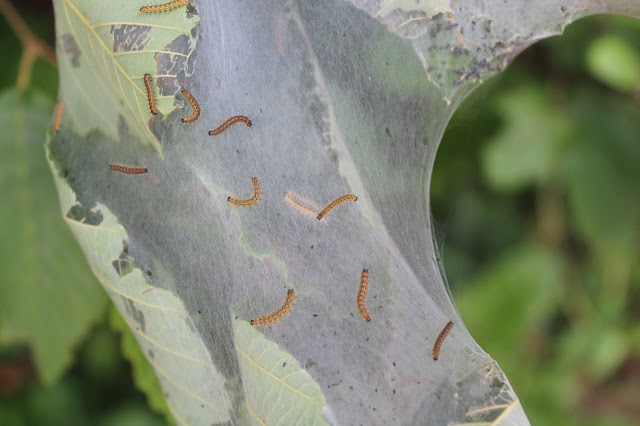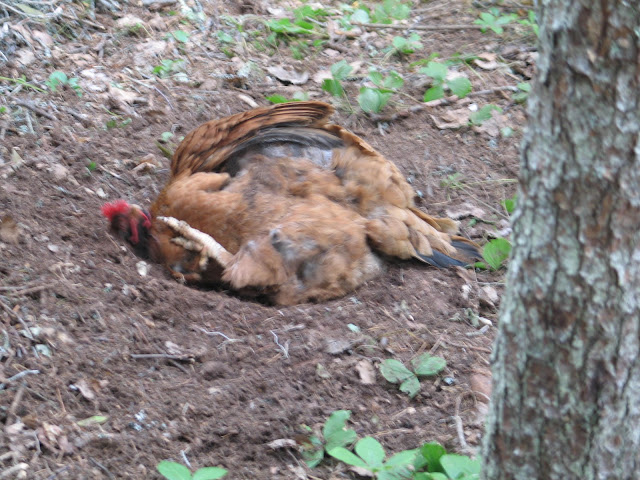I mostly take photographs of moths, at least when it comes to insect life, but sometimes there's something else that catches my eye. This week I noticed two interesting beetles in the screened-in porch area in the morning. I leave the light on at night to attract the moths, and sometimes other insects are attracted as well.
First up is Monochamus scutellatus, which has a number of common names, but is well known as the white-spotted sawyer or spruce beetle. It is a wood-boring beetle that is found throughout North America and is a plague for the forestry industry. On the other hand, they do rely on dead or dying wood for part of their life cycle, and they assist with forest nutrient cycling. Given the fact that we're surrounded by pine and spruce forests - their main habitat - it's not surprising that one showed up. They have extremely long antennae, which make them look quite imposing.
A few days later, I had a visit from the round-headed apple tree borer, Saperda candida. This is also a relatively common beetle that also bores into wood. It has very distinctive white stripes on a dark brown background. It feeds on apple, but also pear, hawthorn, mountain ash and Amelanchier species, among others. In this picture, it looks more black than brown, but it's a dark brown colour in the right light. This one also seems to have had something leave a dark smudge on its back.
Today I saw a bright orange and white caterpillar. There was only this one, on my hosta. I didn't see any damage on the hosta. This is the caterpillar of Pyrrhia exprimens, also known as the purple-lined sallow moth. The moth is not particularly colourful, but the caterpillar is! This colour pattern on the caterpillar doesn't occur until after the fourth moult. Before that, it's green with faint dark dots.
Then there are these caterpillars. Not so interesting. I can't stand tent caterpillars. There are 6 species of tent caterpillar in North America, and I'm not sure which one this group belongs to, although it's likely Malacosoma americanum (Eastern tent caterpillar) or Malacosoma disstria (Forest tent caterpillar). These are on an alder shrub just down the road, but I took some off my flowering crabapple this week, and fed them to Athena!
Happy hen!
Showing posts with label Athena. Show all posts
Showing posts with label Athena. Show all posts
Monday, August 1, 2016
Sunday, July 31, 2016
Athena has a Dust Bath
If you haven't watched a chicken take a dust bath, you're missing out! They are really quite amusing. I decided to let Athena go out in the fenced area today. She isn't likely to try to escape the fencing by flying over it. She's not that kind of chicken. Some breeds are good flyers, but Athena's a bit too heavy for that and she's not the right build. It has been quite a long time since Athena has had the opportunity to be out in an open area, rather than her large dog crates. She did some scratching in the dirt in the outdoor dog crate, but that isn't the same because the metal mesh of the crate prevents full dust bathing.
So finally, today, she went out into the fenced area and the very first thing she did was walk about 5 feet forward to an area with soft earth to start a major dust bath. It was lovely to see her just being a chicken again. The woodsy area has a lot of leaf litter and pine needle debris on the ground, making for lots of soft, ideal dust bathing areas. I took a lot of pictures of her, many of which are blurry, but that's what it looks like when a chicken is dust-bathing - just a blur!
Here you can see she's settled in to a spot for her bath.
She begins turning around and around, scratching in the earth to create a shallow depression in the soil - sort of like a "bowl" shape.
Once she has the area established, she begins kicking dirt onto herself. Here you can see that her head is relatively still, but her back end is a blur because she is kicking up dirt and dust onto her feathers.
She continues to do this many, many times, kicking around the dirt with her legs and shaking it through her feathers.
It's quite amusing to watch her shake and shimmy around. The dust and dirt help to clean oils off her feathers and also help to prevent skin parasites like lice and mites. I check her regularly to ensure she doesn't have any parasites, but this is their natural way of keeping clean.
Once she really gets into the groove, she starts completely rolling over in the dirt. You can see here that her head is upside down and the back of her neck is in the dust bath.
Shake those tail feathers, Athena!
Here she is totally upside-down with her foot up in the air.
Wheeee! Chickens often make contented little noises while dust bathing - soft clucks and burbling noises.
Sometimes they stop part way through their dust bath to take a rest, like in the picture below. This can cause new chicken owners to think that their bird is dead. Nope - she's just resting!
About a half an hour later, I went to check on her again. Still at it! Happy chicken!

So finally, today, she went out into the fenced area and the very first thing she did was walk about 5 feet forward to an area with soft earth to start a major dust bath. It was lovely to see her just being a chicken again. The woodsy area has a lot of leaf litter and pine needle debris on the ground, making for lots of soft, ideal dust bathing areas. I took a lot of pictures of her, many of which are blurry, but that's what it looks like when a chicken is dust-bathing - just a blur!
Here you can see she's settled in to a spot for her bath.
She begins turning around and around, scratching in the earth to create a shallow depression in the soil - sort of like a "bowl" shape.
Once she has the area established, she begins kicking dirt onto herself. Here you can see that her head is relatively still, but her back end is a blur because she is kicking up dirt and dust onto her feathers.
She continues to do this many, many times, kicking around the dirt with her legs and shaking it through her feathers.
It's quite amusing to watch her shake and shimmy around. The dust and dirt help to clean oils off her feathers and also help to prevent skin parasites like lice and mites. I check her regularly to ensure she doesn't have any parasites, but this is their natural way of keeping clean.
Once she really gets into the groove, she starts completely rolling over in the dirt. You can see here that her head is upside down and the back of her neck is in the dust bath.
Shake those tail feathers, Athena!
Here she is totally upside-down with her foot up in the air.
Wheeee! Chickens often make contented little noises while dust bathing - soft clucks and burbling noises.
Sometimes they stop part way through their dust bath to take a rest, like in the picture below. This can cause new chicken owners to think that their bird is dead. Nope - she's just resting!
About a half an hour later, I went to check on her again. Still at it! Happy chicken!

Subscribe to:
Posts (Atom)
















